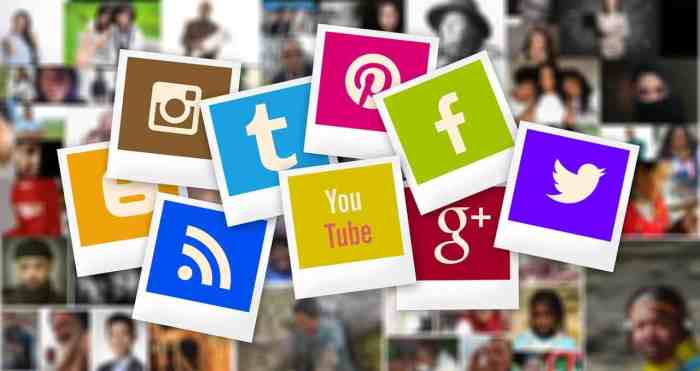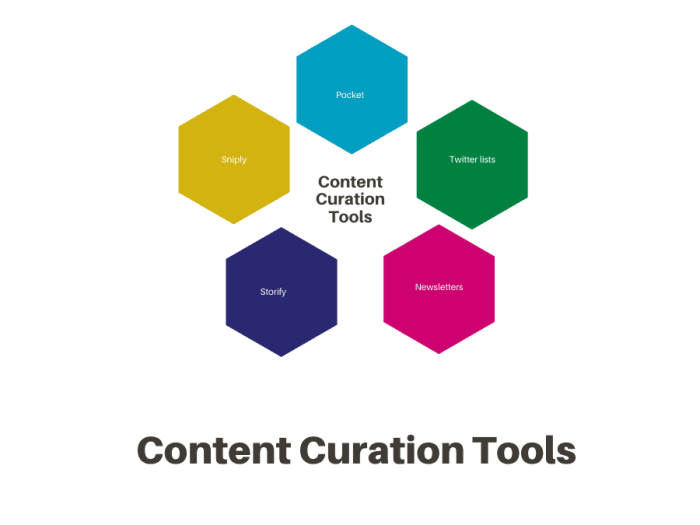Diving into the world of Content Curation Tools, where digital meets curated content in the coolest way possible. From manual to AI-powered tools, we’ve got you covered.
Let’s explore how these tools can revolutionize your content game and take it to the next level.
Definition of Content Curation Tools

Content curation tools are software or platforms used to discover, gather, organize, and share relevant content from various online sources. These tools help individuals and businesses sift through the vast amount of information available on the internet to find and distribute content that is valuable to their audience.
Examples of Popular Content Curation Tools
- 1. Pocket: A tool that allows users to save articles, videos, and other content to view later.
- 2. Feedly: An RSS feed reader that aggregates content from multiple sources for easy consumption.
- 3. Curata: Helps marketers discover, curate, and share relevant content to engage their audience.
The Importance of Content Curation Tools in Content Marketing Strategies
Content curation tools play a vital role in content marketing strategies by enabling businesses to:
- – Save Time: By automating the content discovery process and providing a streamlined way to organize and share content.
- – Build Authority: By sharing valuable and relevant content, businesses can establish themselves as thought leaders in their industry.
- – Engage Audience: By curating content that resonates with their target audience, businesses can increase engagement and build a loyal following.
Types of Content Curation Tools

Content curation tools come in various types to cater to different needs and preferences. Let’s explore the main categories of content curation tools available in the market today.
Manual vs. Automated Content Curation Tools
When it comes to content curation tools, one key differentiator is whether they are manual or automated. Manual content curation tools require human intervention to select, organize, and publish content. On the other hand, automated content curation tools use algorithms and artificial intelligence to gather, filter, and distribute content automatically. Both types have their own advantages and limitations, depending on the user’s goals and resources.
Social Media Content Curation Tools Features
Social media content curation tools are specifically designed to help users discover, curate, and share relevant content on social media platforms. These tools often offer features such as content scheduling, analytics tracking, monitoring, and collaboration functionalities. By leveraging social media content curation tools, users can streamline their content curation process, engage with their audience more effectively, and enhance their social media presence.
Benefits of AI-Powered Content Curation Tools
AI-powered content curation tools utilize advanced algorithms to analyze data, predict trends, and recommend personalized content to users. By harnessing the power of artificial intelligence, these tools can automate the content curation process, improve content relevance, increase engagement, and save time for users. Additionally, AI-powered content curation tools can help users stay updated on the latest industry trends, drive traffic to their websites, and enhance their overall content marketing strategy.
Key Features to Look for in Content Curation Tools
When choosing a content curation tool, it’s essential to consider key features that can enhance your content curation process. These features can streamline your workflow, improve content quality, and increase engagement with your audience.
Content Discovery
Content discovery is a crucial feature in content curation tools that allows users to find relevant and trending content across the web. It helps you stay updated with the latest industry news, trends, and topics, ensuring that you curate timely and valuable content for your audience.
- Advanced search capabilities to find specific content
- AI-powered recommendations based on your interests and preferences
- Integration with RSS feeds and social media platforms for easy content discovery
Scheduling
Scheduling features in content curation tools enable users to plan and organize their curated content for optimal publishing times. This helps maintain a consistent posting schedule and reach your audience when they are most active online.
- Customizable publishing calendar to schedule posts in advance
- Automated posting to social media platforms for efficient content distribution
- Analytics-driven scheduling based on audience engagement data
Analytics, Content Curation Tools
Analytics tools provide valuable insights into the performance of your curated content, allowing you to track metrics such as engagement, reach, and conversion rates. These data-driven insights help you optimize your content curation strategy for better results.
- Comprehensive performance reports and metrics dashboard
- Integration with Google Analytics for in-depth website traffic analysis
- Real-time monitoring of content performance for immediate adjustments
Customization Options
Customization features allow users to personalize their content curation tools according to their preferences and branding guidelines. This ensures that your curated content aligns with your brand identity and resonates with your target audience.
- Customizable templates for curated content presentation
- Brand colors, logos, and fonts customization for a consistent brand image
- Content categorization and tagging options for easy organization
Collaboration
Collaboration features are essential for teams using content curation tools to work together efficiently on content curation projects. It allows team members to share ideas, collaborate on content creation, and provide feedback in real-time.
- Team collaboration tools for seamless communication and task assignment
- Content sharing and commenting features for collaborative editing
- Version control and approval workflows to streamline content review processes
Best Practices for Using Content Curation Tools
Curating content can be a game-changer when done right. Here are some best practices to make the most out of content curation tools:
Effective Content Curation Tips
- Identify your target audience: Before curating content, understand who you are curating for. Tailor your selections to match their interests and preferences.
- Curate diverse content: Mix up your curated content to keep your audience engaged. Include a variety of formats like articles, videos, infographics, and more.
- Give credit where it’s due: Always attribute the original source of the curated content. This helps build credibility and respect in the online community.
- Stay updated: Regularly check for new content to curate. Fresh and relevant content will keep your audience coming back for more.
Balancing Curated and Original Content
- Set a ratio: Decide on a ratio between curated and original content that works for your brand. This could be 70% curated content and 30% original content, for example.
- Create your own content: Invest time and effort into producing original content that complements your curated pieces. This will showcase your expertise and uniqueness.
- Interlink curated and original content: Connect your curated content to your original pieces through internal linking. This improves navigation on your website and keeps visitors engaged.
Engaging with Curated Content
- Add your voice: Provide your own commentary, opinions, or insights when sharing curated content. This personal touch adds value and encourages interaction.
- Promote discussions: Encourage your audience to share their thoughts on the curated content. Ask questions, run polls, or host live sessions to spark engagement.
- Monitor performance: Track the performance of your curated content to understand what resonates with your audience. Use analytics to refine your curation strategy over time.